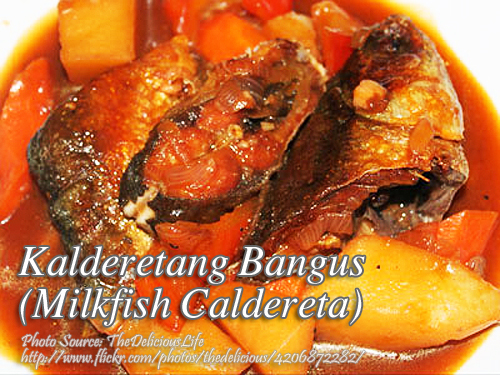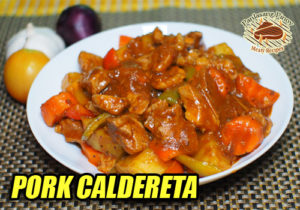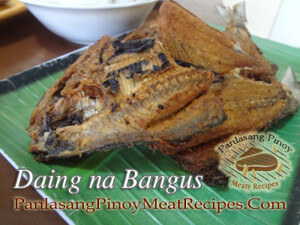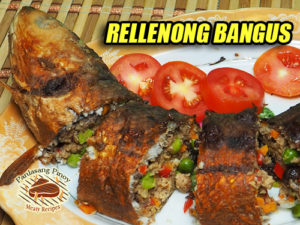Kalderetang bangus is one of the many ways of cooking bangus and one of the varieties of cooking caldereta which is usually red meat. This is also the healthiest kaldereta version because it uses fish. But just take care while frying the fish because you will encounter many oil splashes specially when the fire is set to high. Better use a clear glass or pyrex cover while frying so you can see the through it. I’ve also used kaldereta mix to simplify the cooking.
Kalderetang Bangus: A Family Favorite with a Pangasinan Twist
When I was a kid growing up in Pangasinan, bangus was always part of our weekly menu. My Lola Mila used to say, “Walang kasing sarap ang bangus kapag galing sa dagat mismo,” and she meant every word. But one dish I didn’t expect to fall in love with was kalderetang bangus. The first time I tasted it was during a fiesta in Dagupan. My cousin Aling Dorie made it for the barangay potluck. It looked like your usual caldereta, but with a twist that had everyone going back for seconds.
A Healthier Take on a Classic
Traditionally, caldereta is a rich and hearty stew made with beef or goat, loaded with tomato sauce, liver spread, and often some cheese. But my cousin Dorie wanted something lighter, especially for her husband who had to cut back on red meat. That’s when she tried using bangus instead. It was a hit. Kalderetang bangus still has that bold, savory caldereta flavor, but without the heaviness of red meat. Plus, milkfish is packed with Omega-3s, making this version both delicious and heart-friendly.
Prepping the Milkfish Just Right
When I make this dish now, I always remember what my Tito Romy taught me: “Fry the bangus low and slow, or expect an oil bath!” He wasn’t kidding. Bangus is notorious for oil splatter, especially if the heat is too high. I usually use a clear glass lid when frying so I can keep an eye on it while protecting myself from the little explosions. Don’t skip the salting step before frying. It helps bring out the flavor and crisps up the skin nicely.
Building the Flavors of Kalderetang Bangus
Once your fish is golden and resting in a colander, it’s time to build that comforting caldereta base. I like to use the same oil from the frying pan to sauté garlic and onion. Not only does it reduce waste, but it also carries that hint of fried bangus flavor into the sauce. The onions should be soft and translucent before you move on.
Adding potatoes early lets them soak in all the flavors as they simmer. I pour in just enough water to cover the chunks and wait until they’re tender. Then comes the secret weapon: kaldereta mix. It’s a shortcut, yes, but one that works. It gives you that perfect balance of tomato richness, spice, and a touch of umami without having to build the sauce from scratch. Bell peppers, carrots, and a dash of chili flakes follow for color and that mild kick.
Finishing with Care
The trickiest part is adding the fried fish back into the sauce. Bangus can be delicate, and stirring too hard will break it apart. I usually lay the pieces gently on top and spoon the sauce over them. Let it simmer for a few minutes until the sauce thickens and coats everything beautifully. A splash of patis at the end ties everything together.
Food for Thought: The Evolution of Caldereta
Caldereta is actually Spanish in origin, from the word caldera which means cauldron. Introduced during the Spanish colonization, the dish has evolved depending on the region and the cook. In the North, you’ll find versions with cheese and liver spread. Down South, coconut milk sometimes joins the party. Using fish like bangus is just another way Filipinos continue to adapt and innovate with what’s available and what fits their lifestyle.
Why Kalderetang Bangus is Worth a Spot on Your Table
For beginners, this recipe is forgiving and flexible. It doesn’t demand hours of marinating or expensive ingredients. The kaldereta mix makes flavoring easy, and milkfish is widely available in markets and groceries. You get all the comfort of a Filipino classic with a healthier twist.
Every time I make this, I think of Aling Dorie smiling in her apron, serving up plate after plate to our noisy, happy relatives. This dish isn’t just food—it’s a memory, a family moment, and a reminder that even the most traditional recipes can be reimagined with a little love and creativity.
If you haven’t tried kalderetang bangus yet, I promise it’s worth it. It might just become your new favorite way to enjoy our national fish.
How to Cook Kalderetang Bangus (Milkfish Caldereta)
Ingredients
- 1 pc large milkfish about half kilo, sliced into 4 pieces
- 1 pc potato quartered
- 1 sachet kaldereta mix liquid or powdered
- 1 pc medium size green or red bell pepper sliced into strips
- 1 pc carrot sliced into rounds or disks
- 1 cup grated cheddar cheese optional
- 1/4 head garlic chopped
- 1 pc small size onion chopped
- 2 pcs laurel leaves
- 1/2 tsp. dried chili flakes optional
- patis or fish sauce
- ground black pepper
- cooking oil
- rock salt
Instructions
How to cook Calderetang Bangus:
- Remove the scales, gills and internal organs of the bangus then wash in running water.
- Slice the bangus in a slanting direction and divide it about 4 pieces.
- Rub the fish with salt and fry until golden brown. Place in a colander to drip excess oil.
- In an empty medium size pan heat oil, about 1 Tbps. (get the oil from where you fried the fish) and saute garlic and onion until the onions are transparent and cooked.
- Add the potatoes and pour some water and simmer the potatoes until cooked.
- Pour the kaldereta mix, bell pepper, black pepper, chili flakes and carrots.
- Simmer for a few seconds then add the fried bangus.
- Stir cook for about 3 minutes but be careful not to break the bangus apart.
- When the liquid evaporates and becomes thick in consistency, season with patis according to your taste.
- Turn off heat and serve hot in a serving plate.
Notes
Cooking Tips:
Control the Heat When Frying Bangus
Milkfish tends to splatter a lot due to its natural fat content and moisture. Keep the heat at medium to low while frying to prevent dangerous oil splashes and to allow the skin to crisp up without burning. Using a clear lid like a Pyrex cover helps you stay safe while still monitoring the golden-brown finish.Let the Potatoes Simmer Before Adding the Fish
Add the potatoes early in the sauce-making process so they become tender and soak in the kaldereta flavors. If you add them after the bangus, they might stay undercooked since the fish doesn’t require long simmering. This timing also helps thicken the sauce naturally with the starch from the potatoes.Be Gentle When Mixing in the Bangus
Once the fish is added back into the pan, avoid stirring too vigorously as bangus breaks apart easily. Instead, gently spoon the sauce over the pieces to coat them without damaging the structure. Let it simmer just enough for the flavors to meld and the sauce to thicken slightly.





